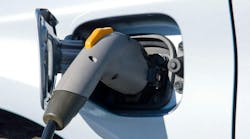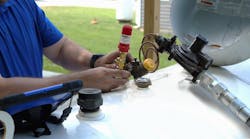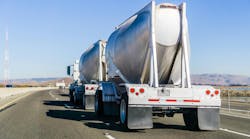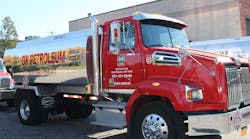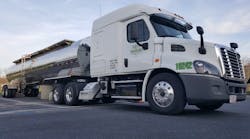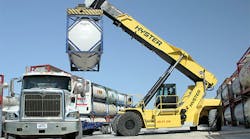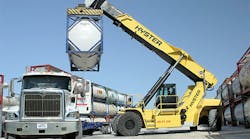TANK container drayage typically is seen as a relatively short-haul activity. However, Best Transportation Service Inc has built a thriving business by offering drayage throughout North America.
From its sole depot in Pasadena, Texas, the carrier regularly transports tank containers to West Coast and East Coast ports and into western Canada and Mexico (via interline service). Best Transportation serves customers with a fleet that includes 122 tractors and 290 drop-frame tank container chassis.
Longhaul drayage movements account for roughly 20% of the carrier’s business today, but the volume is growing steadily. Chemicals make up about 95% of the shipments, but cargoes handled by the carrier range from juices to high-hazard products.
“Our customers have various reasons for requesting long-haul drayage movements,” says Roger W Best, president of Best Transportation Service. “For instance, it may be more convenient or cost-effective for a customer to ship out of one port over another. In addition, certain hazardous materials must be loaded on a ship at the last land point before overseas movement, and we transport these containers to the appropriate port.
“Truck transport also is necessary in some cases to meet tight shipping windows. Finally, we have been moving significant numbers of tank containers into and out of the oil and gas shale plays. Many of these movements are dedicated two-way hauls.
“We’re in the problem-solving business. We just happen to do that with trucks. Our objective is to be the company that can handle any deadline-sensitive shipment involving tank containers. We think we do a very good job of that.”
Family business
Building Best Transportation Service into a company that can handle the most challenging tank container movements for some of the largest chemical companies in the world took a lot of hard work. Tank containers weren’t a factor when three brothers launched the company that became Best Transportation Service in 1978.
Brothers Ralph, Ben, and Tom started the business as Best Delivery Systems Inc, a local hotshot delivery company that served a handful of customers at first. Good service brought steady growth and opportunities for diversification.
Tank containers emerged as a more effective means of shipping specialty chemicals and certain foodgrade products in the 1980s, and the Best family saw what they believed was a good opportunity. In 1988, Best Transportation Service was established to focus on the emerging tank container market.
“The tank container business was taking off, and we saw an opportunity to get involved in a new market niche,” Best says. “We exited the hotshot business years ago to focus on intermodal and never looked back. We’re very optimistic about the future.
“We believe we are in the right place at the right time. We’re in the middle of Houston’s chemical corridor. In addition, we are within easy reach of the population centers of the Midwest.”
Ship channel
Reasons for the optimism include a planned $35 billion project to widen and deepen the Houston Ship Channel to accommodate Panamax II container ships that will begin transiting the Panama Canal. These ships will have a 13,000 TEU (20-ft equivalent) capacity, compared to 5,000 TEU on standard Panamax vessels.
In addition, numerous chemical plant and refinery upgrade and expansion projects are coming online. One example is a new Exxon chemical plant in Mont Belvieu (on the east side of Houston) that will ship 200 container loads of plastic pellets a day to the Port of Houston.
Intermodal accounts for roughly 80% of the Best Transportation Service business today. In addition to tank containers, the drayage company handles box containers and reefers. The carrier also uses vans and flatbeds to transport totes, super sacks, and such.
“We handle 4,000 to 5,000 Flexitanks a year now,” Best says. “Flexibags in 20-ft box containers have become a big growth area for us. The single-use plastic bags are used to ship a variety of liquids, including lubricants and wine.”
Room to grow
With the steady growth in intermodal opportunities over its initial 19 years, Best Transportation Service had completely outgrown the original five-acre terminal south of Houston’s downtown. “We attribute this strong growth to our loyal customer base, strong partnerships, and a loyal and tenured staff,” Best says.
Although Best Transportation Service was constrained on space, demand for service continued to grow. The company was able to forge a relationship with a tank wash facility in Pasadena and began providing tank container cleaning and repair services for its customer base. This allowed the company to continue to grow, but it was still evident that a new terminal was paramount to continued growth. Management began looking for a new location closer to customers.
Best Transportation Service located a 34-acre parcel of land that offered plenty of room to build a state-of-the-art intermodal facility. It took a lot of work to convert the swampy, marshy property into the terminal that the management team envisioned. Most importantly, many truckloads of fill dirt were needed to raise the property level and divert ground water into a retention pond.
In addition to a corporate office building, Best Transportation Service built a seven-bay maintenance shop and a 25,000-sq-ft warehouse. A fully paved loaded storage area provides enough room for up to 600 TEUs. The initial facility opened for business in December 2007.
Since then, the company has added a steel building for exterior vehicle washes and an open-sided structure with work platforms and fall protection for inspecting tank containers on chassis. Two loaded and two empty lifts are available for moving containers around the facility.
Best Transportation Service has contracted with Beacon Thermal Solutions LLC for tank container heating services. Beacon provides both steam and glycol heat from mobile units that are staged at the terminal. The portable 80-horsepower boiler unit can steam-heat eight tanks at a time. The glycol unit can heat up to 16 tanks at a time.
Safe and secure
Every effort is made to ensure that tank containers are handled safely and securely throughout the time that they are in the custody of the Best Transportation Service team. The care starts the minute the carrier takes possession of the container at the port or customer location.
Upon arrival at the Pasadena terminal, the container is given a visual exterior inspection by Best Transportation Service personnel, who document their findings on an equipment interchange report (EIR). The EIR is included in a file with other relevant documents, including bill of lading, material safety data sheet, and customer orders.
Best Transportation Service personnel check on the condition of stored tank containers during a daily walk-around inspection. In addition, stored tank containers are inventoried once a month. Seal numbers are recorded when the tank container arrives and when it leaves.
To ensure security while the container is at the terminal, the facility is staffed 24/7. The terminal is fenced and well lighted. In addition, surveillance cameras are in place throughout the facility and operate around the clock as part of the company’s Spill Prevention, Control, and Counter Measure Plan. The camera system has a 15-day backup.
Best Transportation Service’s fire protection program includes a fire plug with a four-inch valve near the southwest corner of the container storage yard. Fire extinguishers are strategically placed around the storage area. A 20-ft container holds absorbent pads, five-gallon pails, 55-gallon drums, diking material, and granular absorbent as part of the spill containment plan.
Close contact
During drayage, dispatchers stay in close contact with the carrier’s company drivers and owner-operators. The carrier runs TMW software that is used for dispatch, safety, maintenance, accounting, and billing functions. Omnitracs on-board computers have already been installed in all company tractors, and the system will be rolled out to owner-operators in 2015.
In recent years, Best Transportation Service made a major shift from company drivers to owner-operators. “We believe owner-operators are a great fit for us today,” Best says. “We are always seeking to add quality drivers to the fleet. Yet, even with a low turnover rate and long-term retention of drivers, Best works diligently to match driver supply with customer demand.”
Best Transportation Service prefers owner-operators with tractors that are less than 10 years old and have a tare weight under 19,000 pounds. “We want the capability to haul a wide range of cargo, including overweight and oversize shipments,” Best says.
Tank container chassis have come from several manufacturers, including Reinke and Pratt. The 28 newest chassis in the fleet were built by Hyundai, and Best says they are fantastic.
The tandem-axle Hyundai chassis have frame height that is approximately 40 inches off the ground and weigh less than 8,500 pounds. They can transport one loaded tank container or two empties and have a tank lifting capability to remove excess heel from tank containers. Best Transportation Service also runs double-drop chassis that enable tank container loading under low loading racks. The carrier recently switched to LED lighting.
All of the equipment in the fleet is on a 90-day maintenance schedule. Tractor service includes changing engine oil and filter and air filter and inspecting for any signs of wear throughout the vehicles components. Tank container chassis service includes checking brakes, tires, lights, air lines, and wheel alignment. Mechanics also inspect for structural defects.
“Our goal is to keep the wheels rolling in this operation with an exhaustive and proactive maintenance program that allows Best Transportation Service to deliver as promised with every shipment we handle,” Best says. “We expect that, as do our customers.” ♦

